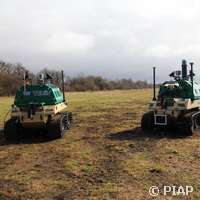Credit: PIAP
Illegal border-crossings in Europe remain an on-going issue, with the latest figures estimated to be nearly 141 000 - up 35 % from previous years. However, the TALOS project has developed a system for transportable autonomous patrol for land border surveillance, which aims to tackle the problem.
The research was coordinated by the Industrial Research Institute for Automation and Measurements (PIAP) in Poland, with funding of EUR 20 million, of which EUR 13 million was provided by the European Commission. The project gathered together a consortium of experienced research teams from industry, research and development, and academia to form three teams.
Together, the teams developed a number of sensors which can detect people, vehicles and hazardous substances crossing the unregulated land border. As well as a concept of unmanned units which are able to perform some autonomous navigation and surveillance tasks, under the supervision of border guards.
Three teams from ten countries helped to develop three subsystems - UGV (Unmanned Ground Vehicle), UUCC (Unmanned Units Command Centre) and a system for communication between all the elements - which were then integrated into one operational system.
Agnieszka Spronska, a member of the coordinating team in the Security and Defence Systems Division at PIAP, says; 'There has been a huge amount of research involved in this project, and we have had to face a number of challenges. One of which has been to get all the teams together from the various countries so that we could integrate all the components of the system.'
She continues: 'This is why everyone working on the project had to come to Poland several times during the integration phase, so that we could further develop and test the system. It was a mammoth task but an interesting experience to work with people from all over Europe.'
So far, the feedback from testing TALOS has been well received by end users and border patrol guards, who have seen the benefits from the operational system. Despite its size, it is easily transportable, particularly when compared to the current infrastructure used for controlling borders.
However, before the system can be officially used, cross-border constraints and the legal framework need to be addressed. This may require some awareness raising and efforts to explain the benefits of such systems - they are more versatile, efficient, flexible and cost effective. However, the TALOS team are hopeful that their system will be fully operational in the near future.
More information: TALOS talos-border.eu/
Industrial Research Institute for Automation and Measurements (PIAP) www.piap.pl/en/
Frontext www.frontex.europa.eu/
Provided by CORDIS






















